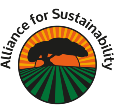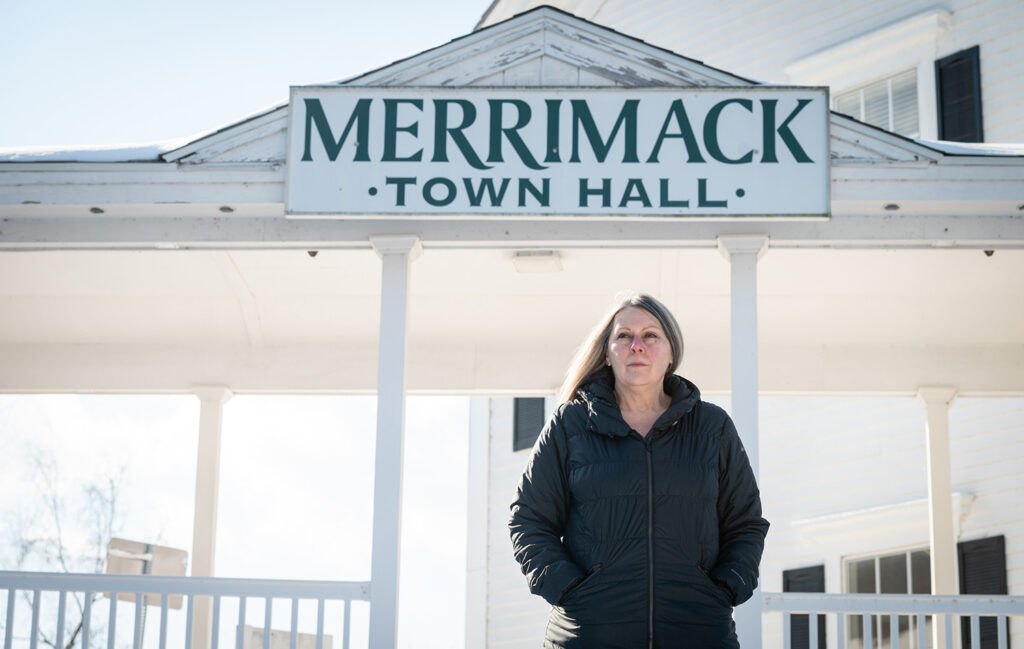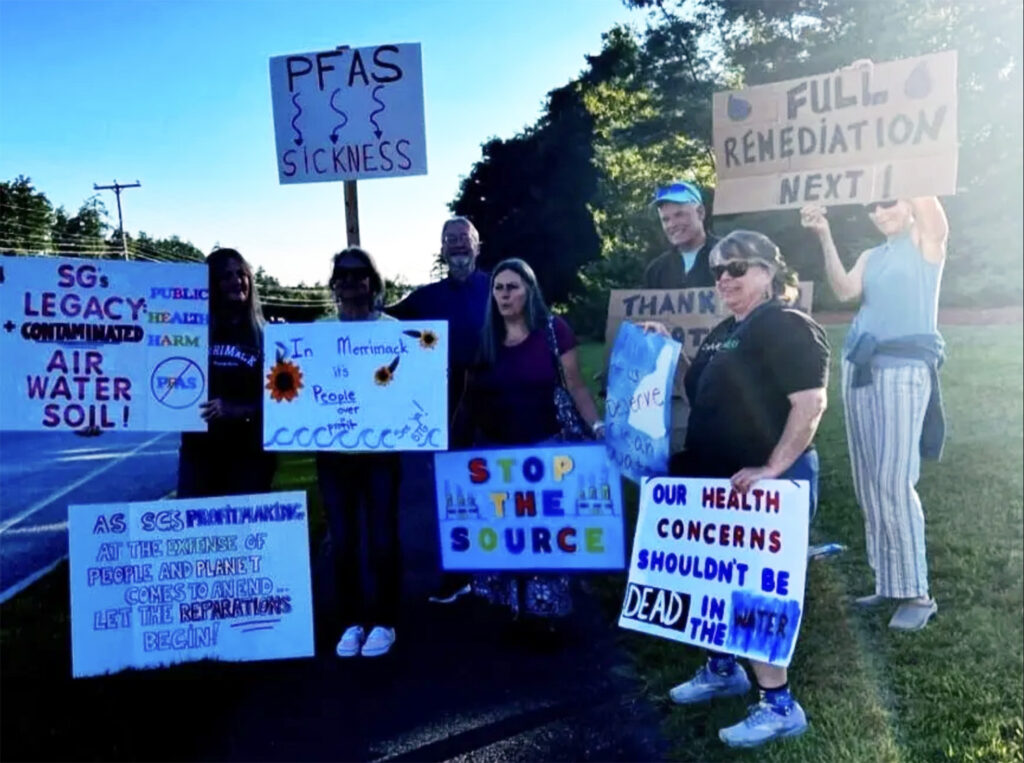By Alliance Communications Coordinator Amy Durr
In 2016 the New Hampshire Department of Environmental Services (NHDES) tested groundwater wells in Merrimack, NH for the first time, and convened a meeting to inform residents of the findings. The results triggered fears that a local plant which coated fabrics was poisoning Merrimack residents.
Concerned resident, social worker and mother Laurene Allen had a feeling the state was minimizing the contamination and concluded that “no one was coming to save us,” according to Sierra. An outraged Allen was spurred into action, becoming a fierce voice for truth and her community.
Allen is exactly the kind of shero (a term coined by Maya Angelou) we need a lot more of in the world today. She deserved being awarded the Goldman Environmental Prize, the world’s most prestigious environmental award.
But as you will see, the battle is far from over as the Trump Administration is doing everything it can to delay action to protect us from PFAS forever chemicals.
And in the meantime, there are specific steps you can take to safeguard you and your family when the federal government doesn’t act. And you can join the Alliance for Sustainability, Clean Water Action MN and other groups in passing state legislation, like we did in Minnesota with Amara’s Law, the world’s toughest ban on PFAS chemicals.
Merrimack’s Toxic PFAS Problem – Facing Extraordinary Hidden Danger
Two of the town’s six public drinking wells, along with dozens of private wells, were found to have PFAS forever chemical contamination greater than the EPA health advisory limit at that time of 70 ppt. That’s 70 parts per trillion, which is such a tiny yet toxic amount that previously was not even detectable. Now we know that even that level was so dangerous that the EPA had to drop the legally allowable limit for PFOA and PFOS – two of the main PFAS chemicals in drinking water – to only 4 ppt, effective April 2024.
As the Goldman Environmental Prize explains:
“Per- and polyfluoroalkyl substances, commonly known as PFAS, are odorless and tasteless substances that have been dubbed “forever chemicals” because of their toxic longevity. First synthesized in the 1940s to repel oil and grease and protect products from water and heat damage, PFAS take thousands of years to break down in natural environments.”
“While not widely known to the public, the chemicals can be found in a huge array of products, including food packaging, cookware, firefighting equipment, personal hygiene items, carpets, and electronics. Because of their ubiquitous use, they are present in animals, human blood and tissue, soil, and seawater throughout the world. A 2022 British Antarctic survey found an alarming increase in PFAS levels in Antarctic snowmelt.”
“Despite numerous studies linking excessive PFAS exposure to deadly cancers and developmental problems in children and infants, regulation has been sluggish. In the US, more than 15,000 registered PFAS are listed in the EPA database, but the chemicals have only recently begun to be regulated. Moreover, enforcement of PFAS use is difficult because of the sheer number of chemical variations and the industry’s constant fabrications of new ones.”
The Authorities Attempt to Downplay the Risks
In the March 2016 meeting, NHDES downplayed the PFAS water contamination risks to residents. Laurene Allen, the shero of this story, left the meeting furious at the authorities’ dismissive attitude toward concerned community members, says the Goldman Environmental Prize.
“She also reflected on unexpected health troubles within her own family and the stories of health patterns emerging from community members. That same night, Laurene reviewed the NHDES slide presentation,” continues Goldman. “After enlarging the corner logo on the slides, she realized that the agency had pulled directly from presentations by the plastics corporation 3M—one of the country’s largest manufacturers of PFAS.”
A Mother’s Valiant Crusade
“And I’m sitting there googling on my phone, and I’m finding more information than is being shared at this meeting. And I’m getting really angry,” Laurene Allen recounts. Credit: The Goldman Environmental Prize
Allen researched and read studies, spoke with scientists and elected officials, cofounded the Merrimack Citizens for Clean Water (MCFCW), and conducted a door-to-door community health survey with group members. Eventually MCFCW identified group members to run—successfully—for elected office, both as state legislators (three of whom became the “water warriors,” as they worked tirelessly on PFAS policy) and as local water commissioners.
Local authorities and elected officials accused Allen of fearmongering — and branded her a “crazy lady.” Sadly, this seems to be the way too many officials demean and decry ordinary people speaking truth to power.
The “Crazy Lady” Refuses to Be Silenced
“With Laurene at the helm, MCFCW kept up local pressure, staging protests outside of the facility and bombarding state regulators with complaints and environmental testing results. The group persuaded the state health department to conduct a cancer incidence report, eventually resulting in an acknowledgement of increased kidney cancer cases,” Goldman continues. “In addition, collaborative engagement with Dartmouth College and Boston University signaled that the findings in MCFCW’s 2017 community survey were not an anomaly.”
“When the plant’s air permit was up for renewal in 2023, Laurene took every measure possible to contest it—testifying at community hearings, providing public comment, and rallying residents in opposition. Despite the public backlash and ongoing contamination crisis, NHDES renewed the Saint-Gobain air permit for five more years.” What an outrageous decision to continue to terrifyingly expose residents to such a proven toxic health hazard.
The silver lining is that her efforts did have an impact on the company, even if the government failed to protect their constituents. It’s a reminder that we can still have power when regulators don’t act.
“Less than one week after receiving its air permit renewal, in August 2023, Saint-Gobain announced its plan to close the Merrimack plant. After fulfilling its production contracts, the facility ceased all manufacturing activities in May 2024. Laurene’s relentless activism created an untenable reality for Saint-Gobain, effectively running the company out of town after one of the largest environmental contamination episodes in the region’s history.”
The EPA’s Current Head Scratching Reversal on PFAS
As I sat down to share about PFAS warrior Laurene Allen, I realized that I would not be using any EPA documents – because I don’t trust them to tell the truth about PFAS. In fact, the “Environmental Protection Agency in the second Trump administration is backing away from key safeguards, funding, and enforcement,” according to EHN. Specifically, they cite:
- The EPA is delaying enforcement of drinking water limits for PFOA and PFOS until 2031 and reconsidering rules for four other PFAS, including GenX, despite years of research showing serious health risks.
- The agency has canceled over $15 million in research grants and slowed tracking of PFAS use, frustrating scientists who say EPA decisions now contradict its own evidence and earlier commitments.
- Staff cuts, grant reversals, and weakened enforcement are raising alarms about the agency’s ability to protect public health, even as communities like Cape Fear, North Carolina, still grapple with contaminated water and mounting legal battles.
The Environmental Working Group (EWG) maps the PFAS contamination crisis. New data show 9,552 sites with PFAS in 50 states, the District of Columbia and four territories. EWG has also found:
- The new data, along with reporting from states and other sources, confirm 172 million people in communities throughout the US have drinking water that has tested positive for PFAS.
- A 2020 study by EWG scientists estimated more than 200 million Americans are served by water systems where two of the most studied PFAS – PFOA or PFOS – were present in drinking water at a concentration of 1 ppt or higher.
Laurene Allen’s Critical Victory Is the Tip of the Spear
Laurene Allen is an American shero to the residents of Merrimack, NH as well as everyone who cares about the rampant and troublesome problem of PFAS contamination. Although she and other activists were able to close the plant, “current plans to address the area’s legacy contamination—which will take thousands of years to dissipate—are unclear due to disagreements between NHDES and Saint-Gobain. Saint-Gobain seeks to demolish the plant without conducting the necessary toxic abatement,” reports Goldman.
Allen’s fight is not over – Merrimack’s drinking water is still contaminated. Our national and international fight is just beginning: PFAS contamination continues to spread and to be discovered. The EPA’s regulations do not apply to well water, according to CNN, nor to manufacturing facilities that use PFAS to create products.
Inside Climate News goes so far as to say, “PFAS Is an Almost Impossible Problem to Tackle—and It’s Probably in Your Food.” In their interview with PEER Director Kyla Bennett, she says “I often make the analogy between climate change and PFAS contamination. If we stopped burning fossil fuels tomorrow, we’d still have 425 parts per million of carbon dioxide in our atmosphere for decades, if not hundreds of years before it slowly starts coming down. That’s not a reason not to do it, we have to do it.”
What Can You Do About PFAS Today?
CNN shares the following recommendations:
For people served by public water systems, start by looking up levels of contaminants in your area. Search EWG’s national tap water database by zip code that lists PFAS and other concerning chemicals.- If PFAS levels are concerning, consumers can purchase an under-the-counter water filter for their tap. NSF, formerly the National Sanitation Foundation, has a list of recommended filters. The water filters that are most effective for PFAS are reverse osmosis filters, which are more expensive, about in the $200 range.
- For people who rent or cannot otherwise install a permanent solution, there are countertop water filters that do a good job of filtering PFAS and some other contaminants.
The PFAS-REACH (Research, Education, and Action for Community Health) project, funded by the National Institute of Environmental Health Sciences, gives the following advice on how to avoid PFAS at home and in products:
- Stay away from stain-resistant carpets and upholstery, and don’t use waterproofing sprays.
- Look for the ingredient polytetrafluoroethylene, or PTFE, or other “fluoro” ingredients on product labels.
- Avoid nonstick cookware. Instead use cast-iron, stainless steel, glass or enamel products.
- Boycott takeout containers and other food packaging. Instead cook at home and eat more fresh foods.
- Don’t eat microwave popcorn or greasy foods wrapped in paper.
- Choose uncoated nylon or silk dental floss or one that is coated in natural wax.


